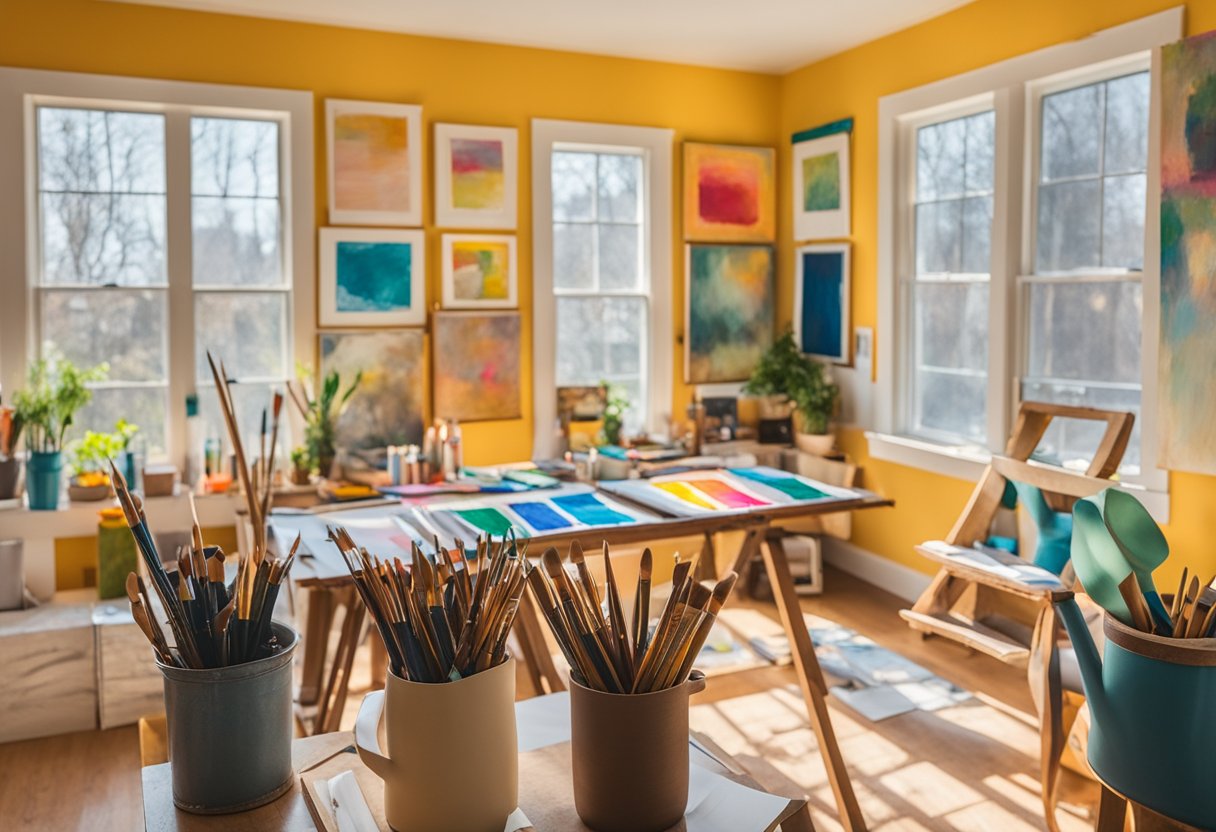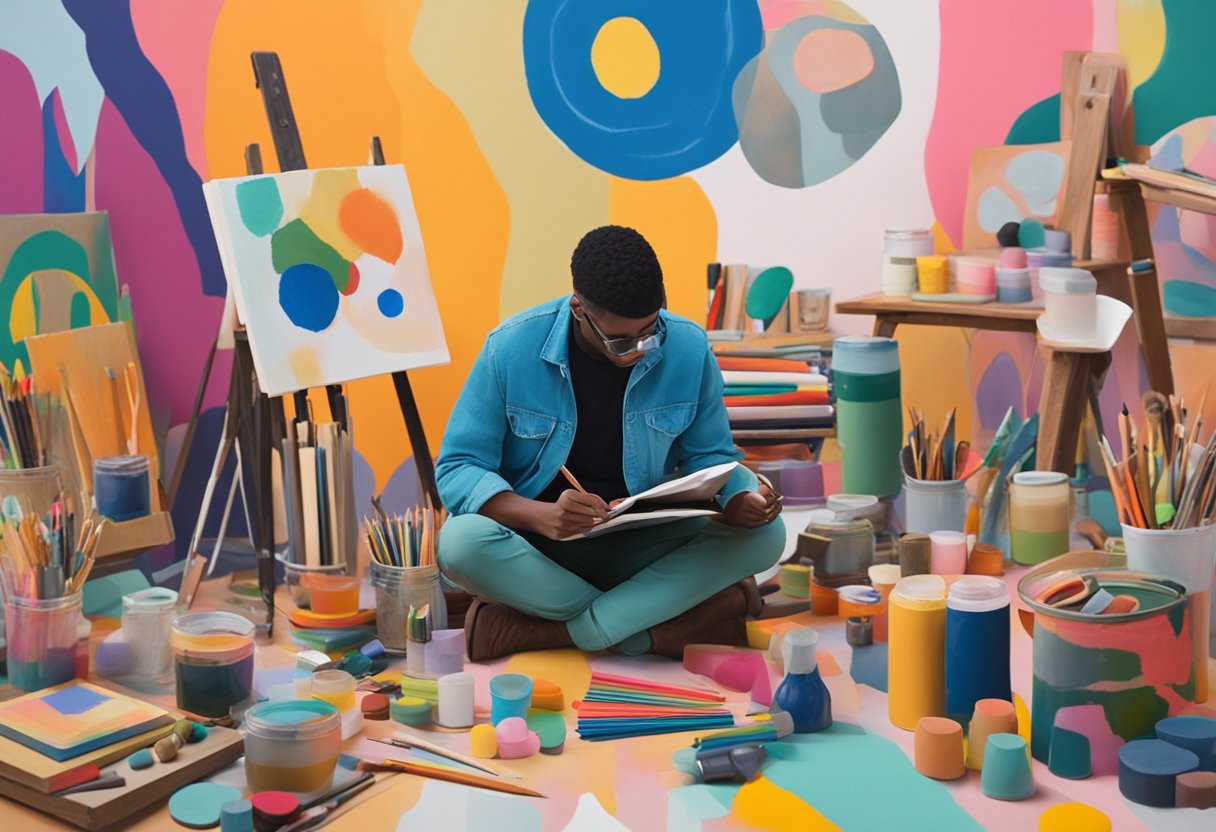Empowering Healing Journeys
Engaging in creative activities can significantly uplift our spirits and improve our quality of life as cancer thrivers. Having survived lymphoma cancer twice, I understand the challenges we face.
From painting and drawing to writing and music, creativity can be a powerful outlet to help us regain our strength and positivity.

Creative pursuits like art, writing, or music can help us express ourselves and stay engaged during treatment.
These activities allow us to manage emotional distress and find joy daily. Art offers a way to communicate our experiences and feelings when words fall short, while music can provide comfort and relaxation.
Being part of a creative community also plays a vital role in our recovery. It provides encouragement, companionship, and new perspectives. By sharing our creative works, we inspire others and build a network of support that aids our mental and emotional well-being.
Key Takeaways
- Creative pursuits enhance our quality of life during cancer recovery.
- Art and music serve as emotional outlets, helping manage distress.
- A creative community offers support and new perspectives.
Understanding Cancer and the Thriver Mindset

Moving from merely surviving to truly thriving with cancer involves a shift in perspective and mindset. We can enhance our journey and foster resilience by embracing positive psychology and creative pursuits.
Shifting From Survivor to Thriver
When we think of ourselves as thrivers, not just survivors, it transforms our experience with cancer. A survivor might focus on getting through treatment, but a thriver seeks to find meaning and joy despite the challenges.
A thriver mindset means engaging in activities that nourish the soul. Creative outlets such as art, writing, or music help us express our journey. Artistic expression allows us to process our emotions. Writing can be a way to share our stories and inspire others. Music provides a therapeutic way to relax and find peace.
The thriver mindset is about being proactive. We take control of our emotional and physical well-being. This includes maintaining an optimistic attitude and actively seeking joyful moments even during tough times.
Positive Psychology and Thriving with Cancer
Positive psychology focuses on the strengths that enable us to thrive. It’s about thinking happy thoughts and fostering resilience and hope. A positive attitude does not ignore the reality of cancer; instead, it emphasizes our capacity to grow and find meaning in the experience.
Hope and faith are significant components of thriving. They help us maintain a forward-looking perspective, even when the road is hard. Mindfulness practices, such as meditation and gratitude, support mental health and resilience.
Additionally, the strength of our imagination plays a crucial role. Visualization exercises can help us see ourselves as strong and healthy. By picturing positive outcomes, we reinforce our ability to achieve them.
The Role of Creative Activities in Cancer Recovery

Creativity can be a powerful outlet during cancer recovery. Engaging in arts, crafts, or music can help manage emotional stress, provide constructive distraction, and improve mental health.
Art Therapy and Emotional Expression
Art therapy allows us to express emotions that words can’t capture. Painting, drawing, and sculpture will enable us to process feelings and release stress. Creating art helped me communicate my journey and inner thoughts better.
Engaging in these activities can reduce anxiety and depression, offering a sense of accomplishment and control during difficult times. According to a study, art therapy helped cancer patients manage their emotional distress and promote positive well-being.
Crafts and Constructive Distraction
Crafts such as knitting, crocheting, and woodworking offer a constructive way to divert our minds from negative thoughts. Crafting keeps us busy and engaged, fostering a sense of purpose. When I focused on woodworking projects, the satisfaction of creating something tangible provided mental relief. Additionally, journaling or writing about our experiences can help us process emotions and track our progress. A study has shown that knitting and similar activities can be therapeutic and support mental health in cancer care.
Music and Movement for Mental Health
Listening to or creating music offers several mental health benefits. Playing instruments, singing, or even listening to favorite tunes can lift our spirits and reduce stress. Music has always been a companion during my recovery, providing comfort and motivation.
Incorporating movement through dance or gentle exercise like yoga can further enhance these benefits. Music therapy aligned with mindfulness strategies has positively impacted cancer patients, helping them live better with the illness.
Incorporating Art into Cancer Care

Creative activities play a vital role in cancer care. They offer emotional release, foster self-expression, and enhance the quality of life for men undergoing treatment.
Visual Arts: Drawing, Painting, and Watercolors
Engaging in visual arts like drawing, painting, and watercolors can be profoundly healing. These activities offer a way to express emotions that might be hard to articulate through words.
Drawing provides a safe outlet for frustration and anxiety. It allows men, especially those battling cancer, to convey feelings without judgment. Painting can be soothing and help relax the mind. Watercolors, with their fluid and unpredictable nature, can symbolize the unexpected journey of cancer treatment. Institutions like Memorial Sloan Kettering support such therapies, recognizing their impact on mental well-being.
Writing as a Form of Self-Discovery
Writing is another effective method for processing emotions and experiences. It can help us unravel complex feelings and promote self-awareness. Keeping a journal allows us to track our journey and reflect on our struggles and triumphs. For men who struggle to express vulnerability, writing can be a private way to confront these issues.
Writing poetry or stories about personal experiences with cancer can be empowering. It can also connect us with others facing similar challenges. The therapeutic benefits of writing are immense and can lead to significant emotional release and personal growth.
The Therapeutic Power of Drama and Performance
Drama and performance art offers another powerful therapeutic outlet. Acting, role-playing, and theater can help us explore different aspects of our identity and emotions. These activities allow us to step out of our comfort zones and express ourselves in new ways.
Performing can build confidence and improve self-esteem. It provides a community of support, as fellow performers often share a deep understanding of the therapeutic process. Participating in drama activities can help us cope with the emotional rollercoaster of cancer treatment, fostering resilience and a sense of accomplishment.
Cultivating a Supportive Community

Developing a supportive community is crucial for us as we navigate life after a cancer diagnosis. We thrive through connections, proper care, and dedicated spaces that empower us to stay positive and engaged.
Connecting with Other Cancer Thrivers
Connecting with fellow cancer thrivers is vital to maintaining a sense of belonging and understanding. Online forums, local support groups, and social media platforms help us share our experiences and offer encouragement. These platforms provide a safe space to discuss our journeys, seek advice, and share creative projects like art, writing, or music. This mutual support can improve our quality of life significantly.
Roles of Caregivers and Counselors
Caregivers and counselors play essential roles in our support network. Caregivers often handle day-to-day tasks and offer emotional support, while counselors provide professional mental health services. Their contributions help us cope with the emotional and physical stress of cancer diagnosis and treatment.
Effective communication between thrivers, caregivers, and counselors ensures our needs are met, and everyone remains resilient throughout the journey. This support structure fosters a nurturing environment.
Recreation Centers and Pediatric Support
Recreation centers and dedicated pediatric support structures are invaluable to us and our families. These centers offer activities like sports, fitness programs, and creative workshops that keep us physically active and mentally engaged.
Pediatric support centers provide specialized care for young cancer thrivers, ensuring they have access to age-appropriate activities and emotional support. Participating in these activities allows us to build strong community ties, which benefit our overall well-being.
Navigating Treatment and Maintaining Positivity

Creativity and humor can help us find joy and boost positivity during cancer treatment.
Engaging in activities like art and music brings balance to our lives.
Keeping Hope During Chemotherapy
Chemotherapy can be a challenging journey, but maintaining hope plays a crucial role in our resilience.
When I went through treatment, engaging in creative activities like painting and writing helped me stay connected to my feelings.
We can express our thoughts and emotions through art, which provides an outlet for stress and anxiety.
Listening to music can also be immensely uplifting. It can transport us to another world, away from the harsh realities of treatment.
Playing musical instruments or enjoying our favorite tunes can bring joy and distraction.
Surrounding ourselves with positive, supportive people can help bolster our spirits and remind us that we are not alone in this fight.
The Healing Effects of Humor and Relaxation
Humor is an essential part of staying positive. Laughter can lighten the mood and release tension.
Watching comedies, reading funny books, or sharing jokes with friends can create a joyful atmosphere.
I found that sharing humorous moments with others facing cancer brought a sense of camaraderie and relief.
Relaxation practices like meditation and mindfulness can also ease our minds.
Focusing on the present moment helps reduce stress and promotes a sense of calm.
Engaging in hobbies such as drawing or crafting can keep our minds occupied and provide a sense of achievement.
These practices contribute to holistic well-being by integrating health, creativity, and relaxation into our daily lives.
Setting Goals and Embracing New Interests
Engaging in creative activities fosters resilience and a sense of accomplishment. Setting attainable goals and exploring new hobbies like art, music, and writing can transform and enrich our daily lives.
Developing Confidence Through Achievements
Setting goals gives us direction and purpose. Our confidence grows when we reach these goals, no matter how small. This is particularly valuable for men who have faced the harsh realities of cancer.
I remember my first painting session after treatment. Initially, it felt challenging, but with time, my artwork improved. This sense of progress was incredibly motivating.
Achieving goals in creative pursuits provides a sense of control and accomplishment.
It’s beneficial to connect each goal to a meaningful “why.” For instance, painting wasn’t just about creating art but expressing emotions I couldn’t express.
This deep connection makes us more likely to stay committed.
Embracing creativity helps set practical goals, increasing self-confidence and personal growth.
Exploration and Experimentation in Daily Living
Exploring new interests can add excitement and joy to our lives. Trying out different activities like music or writing keeps us engaged.
Each new experience offers a chance to discover hidden talents and passions.
After surviving cancer, I took up playing the guitar. It wasn’t about mastering the instrument but enjoying learning something new.
This exploration brought fresh energy into my daily routine and helped me focus on the positive aspects of life.
Trying various activities can lead to finding new hobbies that bring joy and relaxation.
For example, joining a local art group or writing a journal can provide a support system and a creative outlet.
These daily living experiments promote mental well-being and offer a path to continuous personal growth. Embracing new interests keeps our lives dynamic and fulfilling.
Moving Forward: Education, Advocacy, and Empowerment
Empowering women and teens, understanding the critical role of education in cancer survival, and utilizing digital platforms can foster stronger community bonds.
Empowering Women and Teens
Empowering women and teens in the cancer survival journey involves focused education and advocacy.
Through my journey with lymphoma, I learned the significance of access to reliable information and support networks.
Art programs, writing workshops, and music therapy can provide creative outlets. Teens significantly benefit from mentorship programs that build self-confidence and problem-solving skills.
Community centers and online forums offer spaces where they can share their experiences and learn from one another.
Together, we can create an environment that fosters hope and resilience.
The Importance of Education in Cancer Survival
Education plays a critical role in cancer survival. Knowledge about symptoms, diagnosis, and treatment options can significantly impact outcomes.
Awareness of the latest research and medical advancements improves our chances of thriving.
Positive psychology and flourishing concepts teach us to focus on mental well-being.
Engaging in creative activities like painting or music helps us emotionally.
Local hospitals, support groups, and educational platforms are vital resources. They offer workshops, seminars, and materials that keep us informed and empowered throughout our cancer journey.
The Role of Digital Platforms in Sharing Experiences
Digital platforms have revolutionized sharing experiences and advocating for ourselves and others.
Blogs, forums, and social media provide spaces to connect, share our stories, and find comfort in community.
Email newsletters from organizations keep us updated on new treatments and advocacy opportunities. Online support groups offer immediate and accessible support.
These platforms also allow us to engage in positive psychology practices.
They encourage us to document our journeys, focusing on moments of joy and progress.
Through these digital connections, we find strength and solidarity in the global fight against cancer.
Final Thoughts
Creativity can be a powerful tool in our journey as cancer thrivers. Art, writing, and music can help us express emotions that words alone sometimes can’t.
I found that drawing and painting provided a soothing outlet. It became a way to turn my feelings into something tangible, something I could see and touch.
Writing, for many of us, serves as a form of therapy. Journaling or crafting stories allows us to process our thoughts and share our experiences with others. We create connections through our words.
Music brings another layer of comfort. Playing instruments, singing, or listening to our favorite tunes can lift our spirits. It allows us to escape into melodies and rhythms.
Sports, too, offer a unique form of creative expression. Whether through team sports or solo activities, staying active helps us feel engaged and alive.
Creating quilts, knitting, or woodworking can also provide focus and calm. Using our hands to make something beautiful fills us with a sense of accomplishment.
Men with cancer may find creativity in unexpected places. Gardening, cooking, or even building models can be fulfilling. These activities turn our focus from illness to creation.
Engaging in these activities helps us stay present and positive. Each creative endeavor we undertake contributes to our healing journey. We balance our days with moments of joy, expression, and connection.
Let’s continue to explore and embrace these outlets. They remind us that we are more than our diagnosis. We are artists, writers, musicians, and creators, thriving uniquely. -T
Frequently Asked Questions
Creativity can be a powerful outlet for cancer thrivers. This section explores how art, writing, and music can help cancer survivors express themselves and stay engaged.
How can creative pursuits enhance the quality of life for those battling cancer?
Creative activities like music, drawing, and painting can relieve stress and help improve mood. They offer a way to relax and often aid in fighting depression, allowing us to feel more connected and expressive.
What are some recommended arts-based therapies for men coping with cancer treatment?
Men can benefit greatly from activities like sculpting, woodworking, or painting. These creative outlets provide a sense of accomplishment and a tangible way to cope with the emotional challenges of treatment.
What safe and engaging hobbies can bring joy to cancer thrivers during recovery?
Hobbies such as journaling, photography, and playing musical instruments are engaging and can be done safely from home. These activities keep our minds active and present positive distractions from the rigors of recovery.
How can cancer patients integrate creativity into their daily routines for better well-being?
Setting aside 15-30 minutes daily for creative activities like sketching or writing can be highly beneficial. Dedicating a consistent time each day helps make these pursuits a regular part of our lives and ensures we have a creative outlet.
What are the psychological benefits of engaging in creative activities for cancer survivors?
Creative activities help reduce anxiety and improve emotional well-being. Engaging in these pursuits provides a sense of purpose and can help us navigate the psychological challenges of being a cancer survivor.
What considerations should be considered when selecting creative activities for someone with cancer?
It’s essential to choose activities that match our energy levels and interests. This might mean starting with low-energy tasks, like coloring or listening to music. Then, gradually move to more intensive projects.
Always consider personal preferences and physical limitations to ensure a fulfilling and safe experience.
